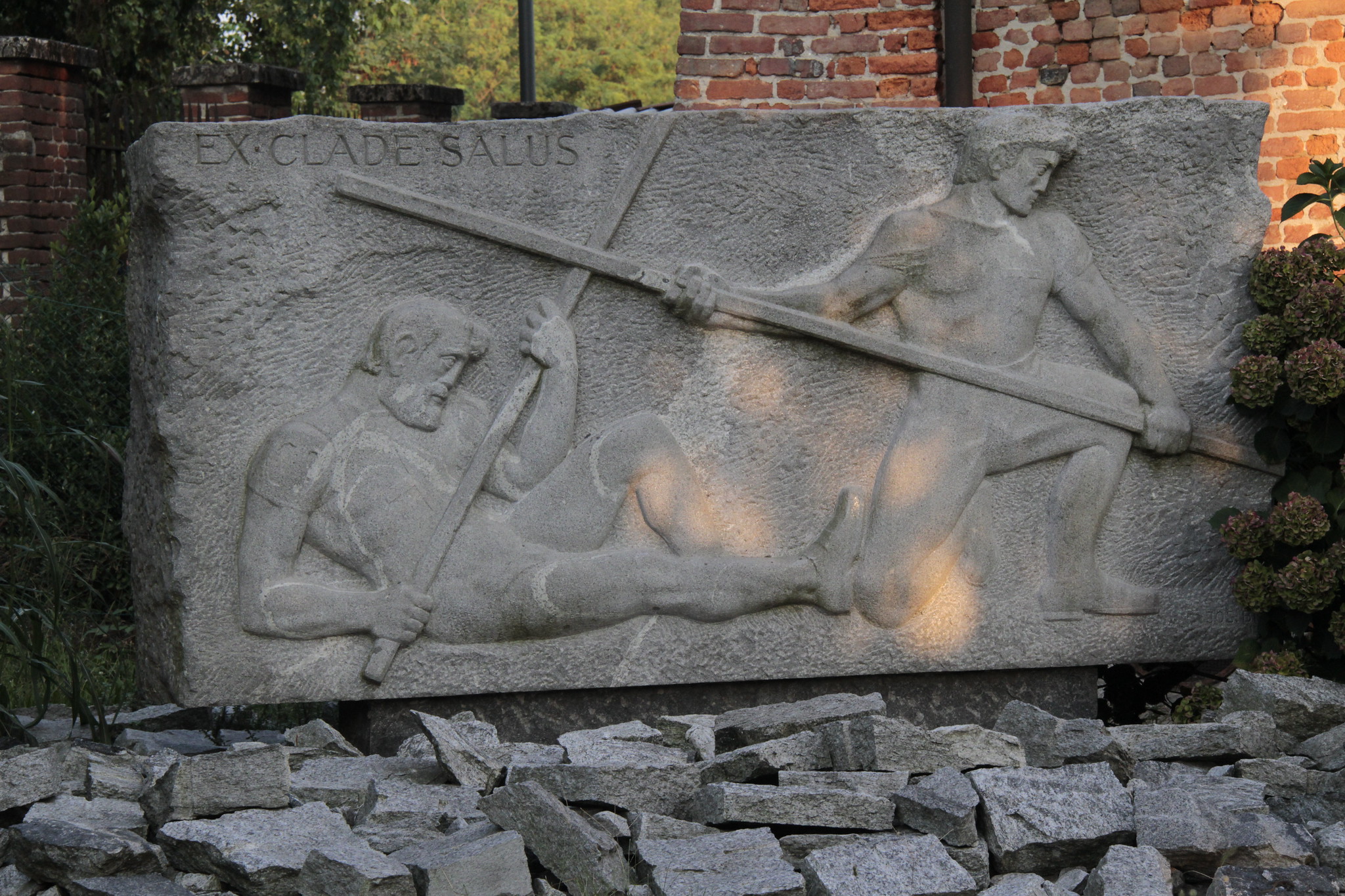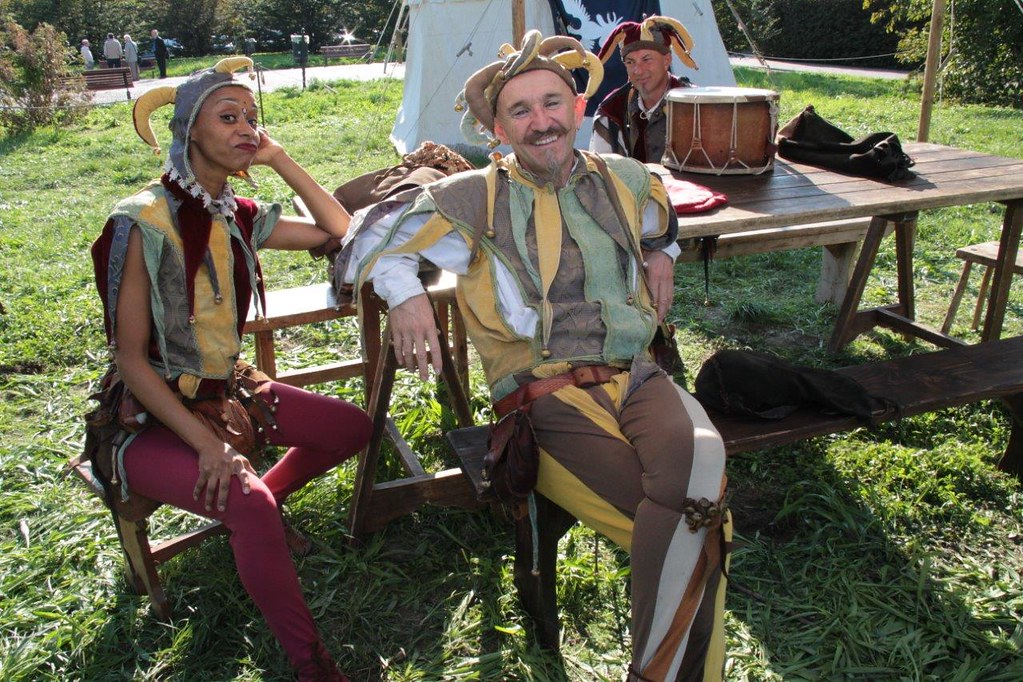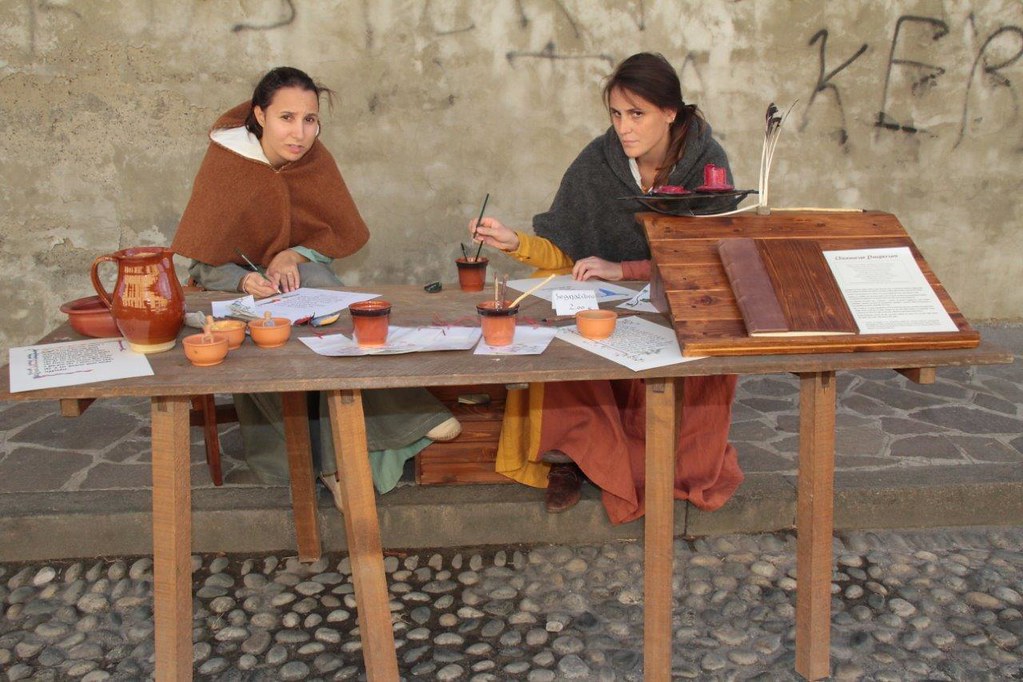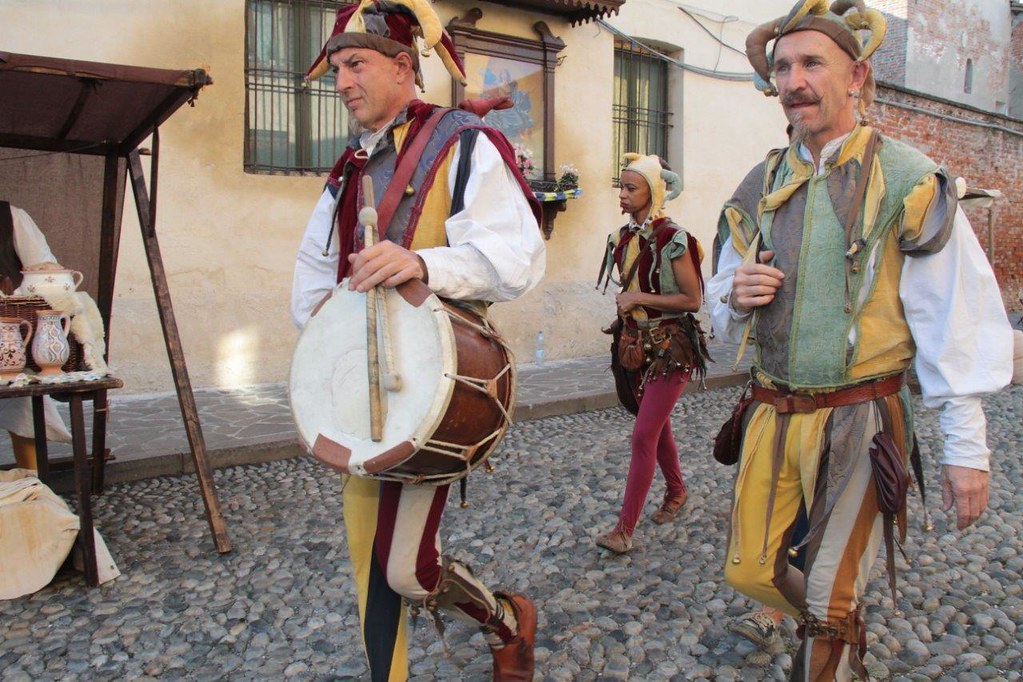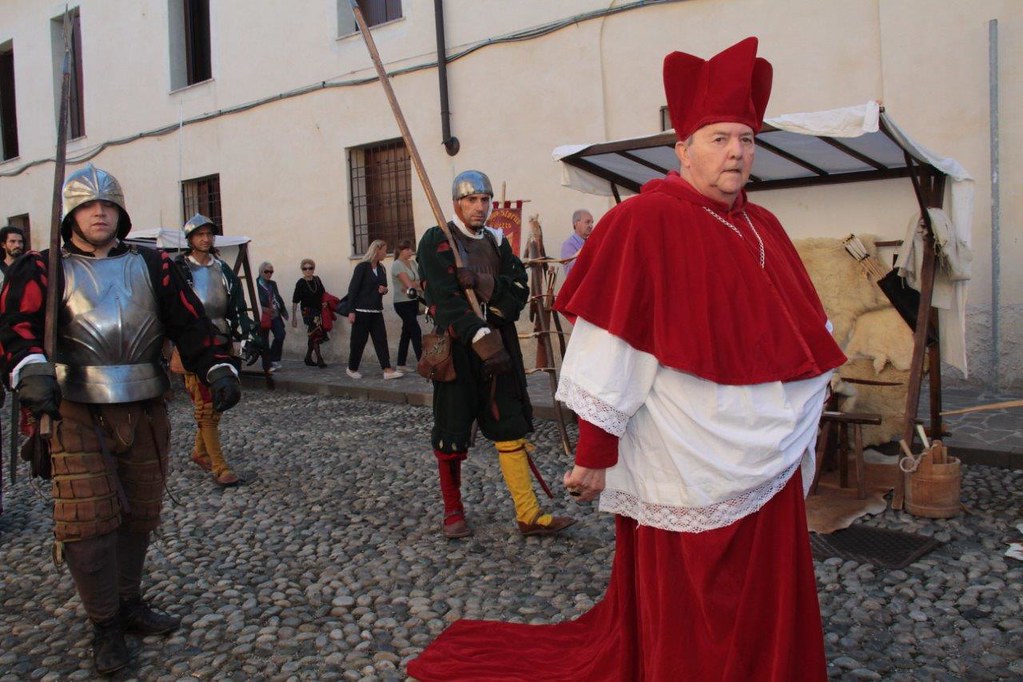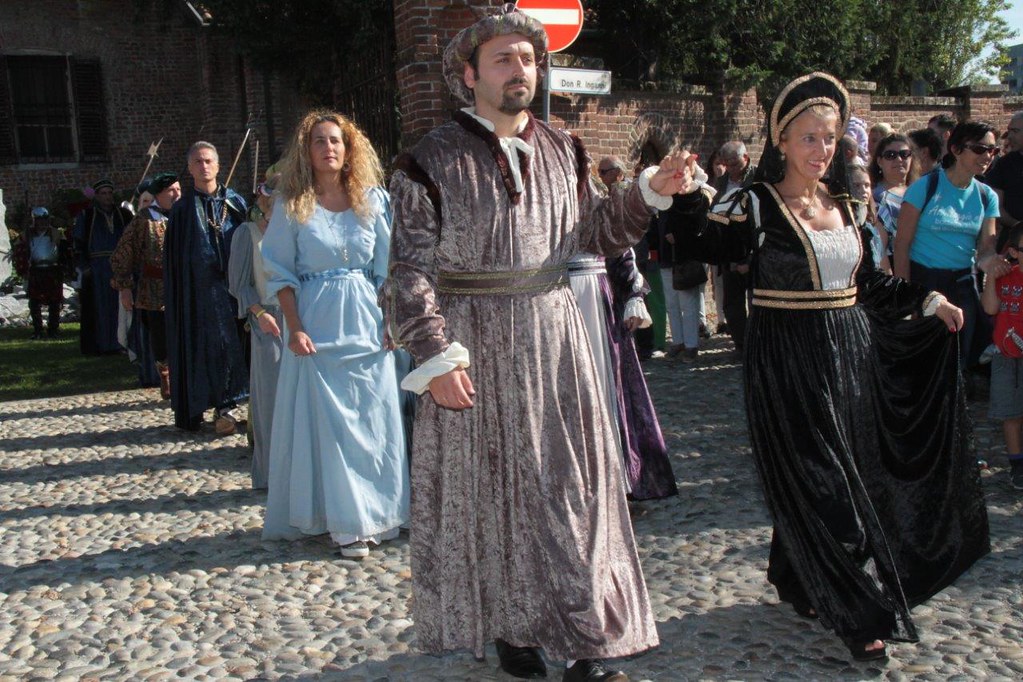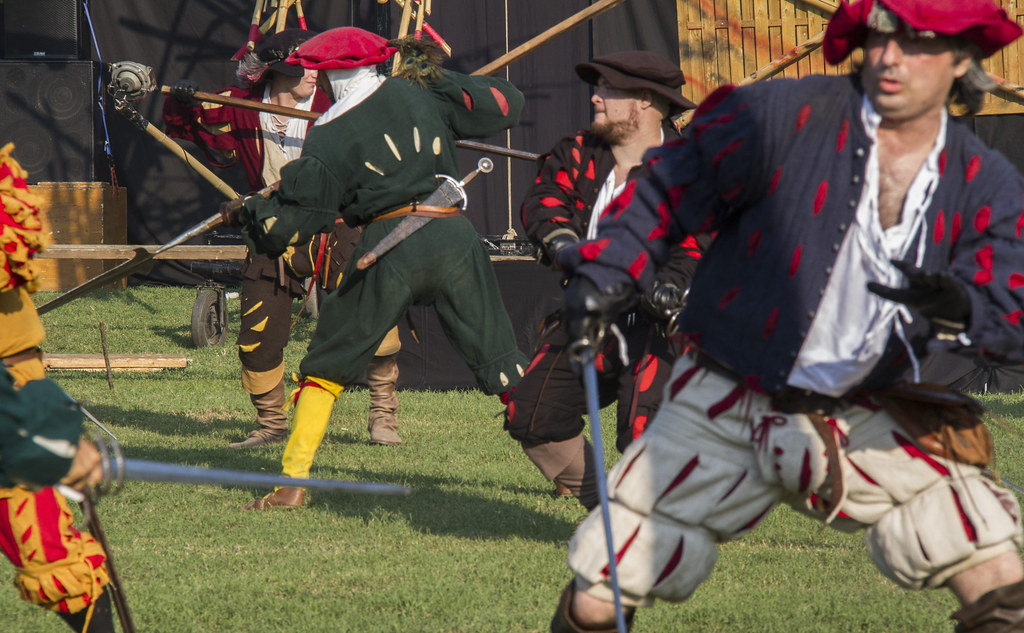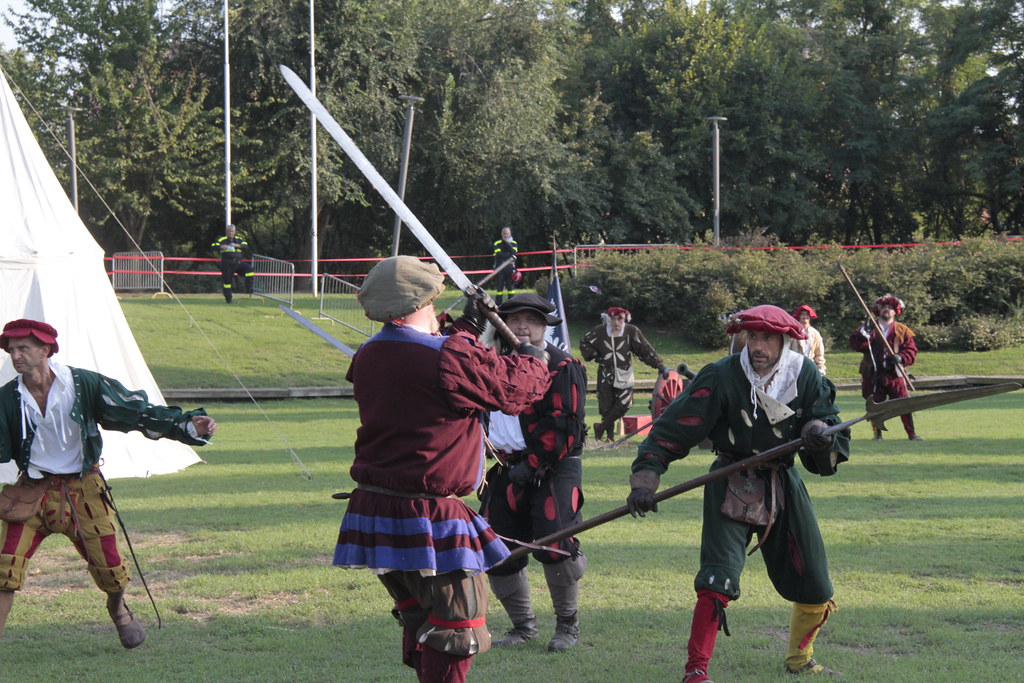Home » Cultura immateriale » The Battle of Giants
The Battle of Giants
Historical Reenactment of the Battle of Marignano
The Battle of Marignano
The Battle of Marignano, also known as the Battle of Giants, was a military clash that took place on September 13-14, 1515, in Melegnano and San Giuliano Milanese, 16 km southeast of Milan, fought over control of the Duchy of Milan. Each year, the town of San Giuliano Milanese commemorates this battle with a historical reenactment featuring a Renaissance Village reconstruction, Historical Parade, and a spectacular display of fire and flames.

The History
On September 12, Massimiliano Sforza, Matthäus Schiner, Markus Röist, and the main Swiss commanders gathered in the stronghold of Milan’s Castello Sforzesco to decide whether to engage in battle with the French. Opinions were divided; some of the Swiss wanted to retreat to their homeland, while others were against a pitched battle due to the French’s favorable position near Melegnano and the possibility of using the support of the Papal troops led by Lorenzo de’ Medici and the Imperial troops under Raimondo de Cardona, stationed near Piacenza. Schiner’s interventionist stance prevailed, supported by most captains and the city garrison.
On the night of September 12-13, Muzio Colonna, commanding a detachment of light cavalry, was ordered to provoke the French, who had been sending small cavalry units to the city gates for days, clashing in skirmishes with the Swiss infantry. On the morning of September 13, the Swiss assembled in the castle square, where Schiner rallied the soldiers, urging them to battle and securing a majority vote by a show of hands. Those opposed prepared to return to Switzerland.
Confident of victory, Schiner mounted his horse at the head of the army, continuing to inspire the soldiers, followed by the cantons most in favor of battle—Glarus, Schwyz, Unterwalden, Uri, and the freiknechte of Bern, Fribourg, and Solothurn, then the Zurich troops, to which joined along the way some cavalry from Sforza and Milanese volunteers. The army moved from the Castle, reaching the Basilica of San Giovanni in Conca, and exited the city through Porta Romana. They then divided into three columns: the first, in the center, comprising the vanguard and artillery, marched along the Via Emilia; the second, to its right, comprising the main body, along the road to Chiaravalle; and the last, to its left, the rearguard, along the so-called “flour road,” which passed through the small agricultural villages of Morsenchio, Triulzo, Monticello, and Bolgiano, arriving at Zivido. It was this column that encountered French outposts near Monticello and Bolgiano, now urban centers of San Donato Milanese, whose troops were forced to retreat toward Melegnano. Meanwhile, the vanguard had inexplicably fired a volley of ten falconets, apparently to further raise morale, a move that eliminated the possibility of a surprise attack on the French that day. However, the French had already been informed of the Swiss movements by light cavalry, spies, and even prisoners whose initial reports were dismissed.
In the late afternoon, Muzio Colonna proposed camping in the meadows between the villages of Civesio and Borgo Lombardo, protected on each side by the Vettabbia and the Redefossi canals, but his advice went unheeded, and it was decided to continue towards the village of San Giuliano Milanese, which, partially burned, concealed the enemy camp. The French were quartered north of Melegnano, between Zivido and Rocca Brivio, in an expanse of fields protected to the west by the Vettabbia, the Redefossi, the Spazzola canal, and other minor ditches, to the east by the Lambro River, and to the north by a fortified canal that Trivulzio and Pietro Navarro had built with a high embankment serving as a bastion. South of this canal, near Zivido, the vanguard—comprising 100 select heavy cavalry from Trivulzio and several detachments of French infantry and Navarro’s Gascon crossbowmen—was camped and led by Charles III of Bourbon-Montpensier. The main body of the French army and the headquarters of Francis I were located near Cascina Santa Brera, while the rearguard, led by Charles IV of Alençon, was stationed near Rocca Brivio. Overall, the French encampments spanned about three kilometers.
First Day
The Swiss arrived just north of Zivido, where they positioned their artillery and began firing on the French positions, who returned fire. Around four in the afternoon, a squadron of 2,000 Swiss pikemen, after crossing the Spazzola ditch and the Redefossi canal, moved to assault the embankment defended by Navarro’s artillery and infantry, managing to cross it and capture seven pieces of artillery at the cost of numerous casualties, then pursued the enemy in retreat. According to Le Moine, the assault succeeded only after an initial charge was repelled by lancers and artillery, which had caused so many deaths that the moat protecting the embankment was filled with bodies.
At this point, the French launched a few hundred heavy cavalry against the bulk of the Swiss infantry, numbering up to 14,000 men, which had arrived, but the charge’s effectiveness was diminished by the nature of the terrain, rich in ditches and moats. Among the fallen was Francis de Bourbon, Duke of Châtellerault and brother of Charles. A contingent of 1,200 Landsknechts, initially positioned to defend the embankment, arrived to aid the French by attacking the flank of the Swiss infantry, but they were quickly defeated, forced to retreat, and pursued by 8,000 Swiss.
Seeing that the vanguard was now giving way, Francis I decided to attack them personally with 300 heavy cavalry, 5,000-6,000 Landsknechts, and some artillery pieces. During the clash, the Swiss and Landsknechts appeared so similar that it was difficult to distinguish them. This was followed by an assault led by some units of cavalry and thousands of French infantry under the command of Charles of Bourbon. Francis I’s maneuver allowed the French to avoid disaster, forcing the Swiss to encamp for the night in a marshy area known as “il pontile,” near San Giuliano Milanese, protected on all sides by woods, ditches, or moats.
Around eleven o’clock, Schiner, Röist, and Engelhart met in a house in the village to decide what to do next.
Second Day
During the night, the French launched several attacks to try to force the Swiss to abandon their positions, but they did not succeed. Trivulzio had his sappers flood the moat that protected the aforementioned embankment. Shortly after dawn, the two armies lined up for battle.
The center of the Swiss formation was held by the “old cantons”: Uri, Glarus, Unterwalden, and Schwyz, who were assigned the task of assaulting the main body of the French army. On the left wing were the cantons of Basel, Schaffhausen, and Lucerne, who were to flank the Duke of Alençon, scattering his ranks before supporting the central body against the king. On the right, Appenzell, St. Gallen, and Zurich, the least motivated for battle, were positioned to withstand the French attack led by Charles III of Bourbon. Among the Zurich troops was a young chaplain named Zwingli, an important figure in the Protestant Reformation.
As planned, the central body of the Swiss attacked the corresponding French forces, but before reaching them, enemy artillery decimated their ranks, causing some, terrified by cannon fire, to abandon the field. The remaining soldiers attempted again to bypass the moat and embankment defending the camp, but suffered heavy losses as they were continually targeted by the crossbow bolts of the Gascon crossbowmen and the alternating fire of the arquebusiers, who took turns reloading their weapons. After crossing it, they managed to capture sixteen cannons, but were soon confronted by the Landsknechts and the royal cavalry. In the melee, even Francis I himself was injured. Trivulzio’s knights and Navarro’s troops then moved against the left flank of the Swiss central body, forcing it to fight on two fronts.
Around noon, the Swiss, having captured four cannons but running low on ammunition or with muskets malfunctioning due to wetness, were forced to retreat. Meanwhile, around nine in the morning, the Swiss left wing, comprising 5,000-6,000 men, had managed to rout the cavalry of the Duke of Alençon, but captains Aymar de Prie and Robert Stuart d’Aubigny managed to regroup the fleeing troops and resisted, preventing the Swiss from reaching the left flank of the French central body.
A few hours after the fighting began, an army of 12,000 Venetians led by Bartolomeo d’Alviano arrived on the field and attacked two infantry units of the Swiss left wing from the flank. Initially, they managed to resist, dispersing the Venetian cavalry, but eventually, overwhelmed by the significant numerical disadvantage, they fled, pursued and decimated by enemy knights. The Swiss under the command of Trüllerey of Schaffhausen entrenched themselves in the village of Zivido and, after putting up fierce resistance, perished in the fire set by Venetian soldiers and artillery. Believing the battle to be lost, the Swiss right wing retreated in order toward Milan without fighting. The Venetians were thus able to attack the Swiss central body from behind, determining the outcome of the battle. Francis I, persuaded by Trivulzio, decided not to pursue the enemy, unlike the Venetian stradiots.
According to the chronicle of the time, moved by the massacre, Francis I had solemn Masses celebrated for three days in the church of San Giuliano Milanese, and later (1518) had the expiatory chapel of Santa Maria della Vittoria built, with an adjoining monastery, entrusted to the Celestine Fathers of France. Among the French commanders was also Gaspard I de Coligny, responsible for coordinating with the Venetian troops. His role must have been significant and skillfully carried out, as he later received the title of Marshal of France from Francis I.
Consequences
With the Peace of Noyon (1516), Milan was returned to France. The peace treaty between France and Switzerland, called the Treaty of Fribourg, was never broken again until the decisive intervention of Napoleonic France in Switzerland at the end of the eighteenth century.
Marignano established the superiority of French artillery (made from bronze alloy) and cavalry over the Swiss infantry’s phalanx tactics, which had until then been nearly invincible. Also important was the use of trenches and field fortifications to stop the Swiss (a tactic already employed by the Italians and Spanish for the same purpose) and the extensive use of firearms and crossbows to weaken the sturdy Swiss squares. Once again, the Landsknecht pikemen failed to withstand the impact with the Swiss pikemen: despite the support of cavalry and artillery, the Swiss broke through the first line in just one hour on the first day, advancing a mile, and only darkness saved the second line. When combat resumed, the Landsknecht line was broken again.
Marignano also marked the end of the Swiss expansionist adventure. After an impressive series of victories (over the Duke of Burgundy, against the imperial army of Maximilian I of Habsburg, and against the French in Lombardy), the Confederates no longer attempted extraterritorial military offensives. Following the defeat, the Confederates lost their influence over the Duchy of Milan and ceded to France the bailiwicks acquired two years earlier with the Battle of Novara (1513): Valcuvia and Valtravaglia. The Valais, which had fought alongside the Confederates, also lost the Val d’Ossola.
Historical Reenactment
Today, Zivido is a cheerful and modern neighborhood in the city of San Giuliano Milanese, running parallel to the Via Emilia. However, it also retains its “old” district, with cobblestone streets and new, low, colorful, well-kept houses along Via Corridoni. At the beginning of this street, it intersects with the road dedicated to Don Raffaele Inganni, the historical figure who would reveal to us the story of the Battle of Giants, and ends at the Brivio Sforza Square, where the Castle is located, within which part of the history unfolded.
It is specifically in the neighborhood of Zivido that the historical reenactment is celebrated every year, with parades, processions, and performers representing the historical figures who brought life (and death) to the distant year of 1515. The stunning costumes of ladies and knights stand out, especially the crimson red attire of “Cardinal Mathaus Schiner,” who fought in battle alongside the Duke of Milan and the Swiss troops. The armor and weapons of the soldiers gleam in the afternoon sun, as they demonstrate how the battles with swords and lances took place. An unmissable reenactment.
Fonti: Wikipedia, Portale Svizzera, RecSando
Fotografia: RecSando – ( partner di Ecomuseo della Vettabbia e dei Fontanili APS )
Altri Album Fotografici sulla Rievocazione Storica – By RecSando
Traduzione: Piera Scudeletti – EVF


